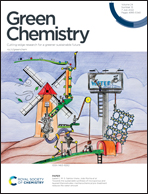Utilization of Si/SiOx/Al2O3 materials from recycled solar cells for a high-performance lithium-ion battery anode†
Abstract
With the rapid growth of solar energy, recycling and reuse of end-of-life solar modules have become a critical issue. In light of this, a simple, yet environmentally friendly, ball milling process was used to transform the recycled Si of waste solar cells into a lithium ion battery anode material. The ball-milled recycled Si was further combined with a carbon fiber paper (CP) substrate to fabricate a composite electrode. The milling time and rotation speed were optimized to form a Si/SiOx/Al2O3 active material with a moderate primary particle size, agglomeration extent, and oxidation states of Si and Al. These features allow the recycled Si to exhibit promising cycling and rate performances. Additionally, introducing a hydrothermally treated CP substrate can further improve the electrochemical performance of the composite electrode, delivering a high discharge capacity of 1603 mA h g−1 after 100 cycles (capacity retention of approximately 91% (200 mA g−1)) and 813 mA h g−1 at 2000 mA g−1, due to the presence of nitrogen-containing groups, particularly the pyridinic-N group. This is evidenced by the reduced solid electrolyte interface and charge transfer resistances and the increased ion diffusion coefficient of the Si/SiOx/Al2O3-based cell.



 Please wait while we load your content...
Please wait while we load your content...